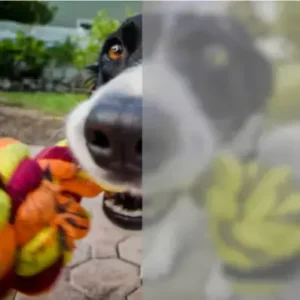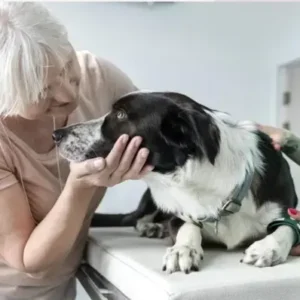Causes of Cataracts in Dogs
Cataracts in dogs can develop due to various factors:
- Genetics: Certain dog breeds including Poodle, Cocker Spaniel, and Boston Terrier are genetically predisposed to cataracts.
- Age: Like humans, older dogs are more likely to develop cataracts as part of the natural aging process.
- Secondary Causes: Cataracts can also develop as a result of other health issues such as diabetes, eye injuries, or inflammation.
Understanding the causes of cataracts can help pet owners identify the risk factors in their dog’s health and lifestyle.
Symptoms of Cataracts in Dogs
As cataracts develop, the affected eye may become cloudy or bluish. However, the symptoms may not be immediately obvious.
Some common signs include:
- A noticeable change in your dog’s eyes, such as a cloudy or opaque look.
- Behavioral changes like bumping into objects or difficulty navigating in low light.
- A sudden decrease in your dog’s ability to see, particularly in bright or dim lighting.
- Inflammation within the eye or surrounding areas of your dog’s eye is commonly referred to as a ‘red eye.’
If you notice any of these symptoms, it’s essential to take your dog to the vet for a proper diagnosis. It’s important to distinguish cataracts from other common eye conditions like glaucoma or cherry eye, as each requires different treatment strategies.
Stages of Cataracts in Dogs
Cataracts in dogs develop progressively in distinct stages:
- Incipient Stage: Less than 15% of the lens is affected, with no significant vision loss. These early cataracts are often small and barely noticeable. Surgery is rarely needed at this stage.
- Immature Stage: The cataract covers 15-99% of the lens, causing variable vision impairment. Dogs may struggle with blurry vision, but surgery might be considered depending on the severity.
- Mature Stage: The cataract covers 100% of the lens, leading to near blindness or complete blindness. Dogs can only detect light changes, and surgery is recommended if other health conditions are stable.
- Hypermature Stage: The lens shrinks, and the capsule wrinkles. This stage often causes complications like lens-induced uveitis. Although dogs are not colorblind, their vision is severely impaired, and surgery is usually needed.
Early detection and intervention help preserve your dog’s vision. Understanding the stages of cataracts allows for better management and treatment decisions. As dogs age, they may develop many eye health issues such as nuclear sclerosis. This condition causes the lens to cloud, but it usually doesn’t affect vision as much as cataracts.
Breeds at Higher Risk
These breeds are more likely to develop cataracts due to genetic predispositions or other underlying health conditions.
- American Staffordshire Terrier
- French Bulldog
- Labrador Retriever
- Miniature Poodle
- Miniature Schnauzer
- Boston Terrier
- Siberian Husky
- Yorkshire Terrier
- Welsh Springer Spaniel
Diagnosing Cataracts in Dogs
If you suspect your dog may have cataracts, it’s important to have them examined by a veterinarian. The vet will typically perform an eye exam to check for cloudiness in the lens.
Your vet may conduct the following tests:
- Slit Lamp Biomicroscopy: A special light is directed into the dog’s eye to allow for a detailed examination of the lens.
- Schirmer Tear Test: A small strip of filter paper is placed inside the dog’s lower eyelid to measure tear production by testing the moisture content when removed.
- Fluorescein Stain: A neon orange or yellow ocular stain is applied to the eye to check for corneal defects, such as scratches or foreign materials.
- Tonometry: After numbing the eye’s surface with drops, the vet uses a small “pen” to gently tap the eye and measure intraocular pressure.
Treatment Options for Cataracts in Dogs
The treatment for cataracts in dogs depends on the severity of the condition. Dogs diagnosed with diabetic cataracts can also achieve a similar success rate with surgery. Some of the most common options include:
- Surgical Removal: The most effective treatment for cataracts in dogs is surgery to remove the affected lens and replace it with a synthetic lens. This procedure is safe and often results in improved vision, especially if done early.
- Non-Surgical Management: In cases where surgery isn’t an option, your vet may suggest managing the condition with medication or special anti-inflammatory eye drops to reduce inflammation and slow the progression of cataracts.
The condition remains treatable with surgery, but if left untreated, it can progress into glaucoma. While not all untreated cataracts lead to glaucoma, dogs with glaucoma are often not a good candidate for cataract removal surgery.
Post-Surgery Care and Recovery
After cataract surgery, your dog will need time to recover. Recovery can take several weeks, and your vet will provide specific instructions for at-home care, such as administering eye drops and preventing your dog from rubbing their eyes.
It’s important to monitor your dog for signs of infection or complications, such as swelling or discharge from the eye. In most cases, dogs recover fully and experience a significant improvement in their vision.
Prevention and Managing Risk Factors
While you can’t always prevent cataracts, there are ways to manage the risk factors:
- Regular Eye Exams: Early detection is key. Regular veterinary check-ups can help catch cataracts in their early stages, allowing for timely intervention.
- Managing Underlying Conditions: If your dog has diabetes or another condition that increases the risk of cataracts, managing these health issues can help reduce the likelihood of cataract development.
- Eye Health Maintenance: Keeping your dog’s eyes healthy with proper care and nutrition can support overall eye health and reduce the chances of cataracts forming.
When to Consult Your Veterinary Ophthalmologist
If you notice any changes in your dog’s behavior or eye appearance, it’s important to consult your veterinarian immediately. Early diagnosis and treatment can make a significant difference in your dog’s quality of life and visual outcomes.
Cataracts in dogs are a serious but treatable condition. By staying vigilant and seeking prompt veterinary care, you can help your dog maintain good eye health and quality of life. If you notice any signs of cataracts, don’t hesitate to schedule an eye exam for your furry companion.








